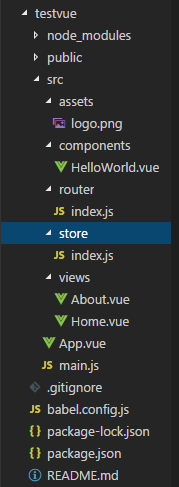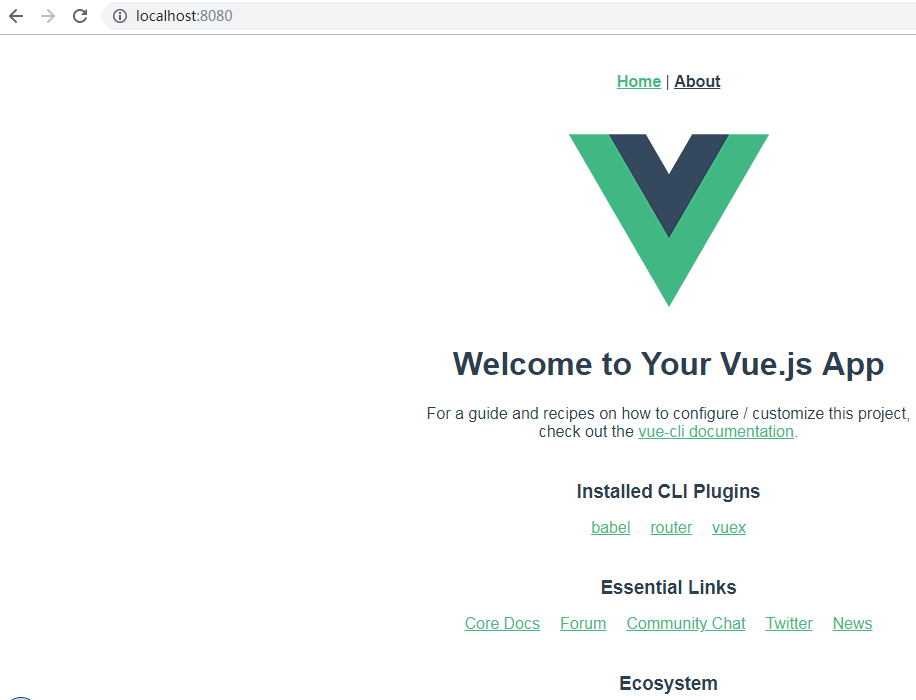vuejs之vue和springboot后端进行通信
一、新建一个vue项目,建立好后的相关文件
查看一下新建好的vue项目的结构:

当前各个文件中的内容:
App.vue:主入口
<template>
<div id="app">
<div id="nav">
<router-link to="/">Home</router-link> |
<router-link to="/about">About</router-link>
</div>
<router-view/>
</div>
</template> <style>
#app {
font-family: Avenir, Helvetica, Arial, sans-serif;
-webkit-font-smoothing: antialiased;
-moz-osx-font-smoothing: grayscale;
text-align: center;
color: #2c3e50;
} #nav {
padding: 30px;
} #nav a {
font-weight: bold;
color: #2c3e50;
} #nav a.router-link-exact-active {
color: #42b983;
}
</style>
main.js:Vue.config.productionTip用于切换是生产环境还是开发环境。这里创建Vue对象的时候同时关联上了App.vue中的id名为app的div标签。引入路由router的js文件以及存储数据的store。
import Vue from 'vue'
import App from './App.vue'
import router from './router'
import store from './store' Vue.config.productionTip = false new Vue({
router,
store,
render: h => h(App)
}).$mount('#app')
router/index.js:这里定义路由对应的模板。有两种方式,一种是在开头先引入,例如Home.vue。另一种是先不引入,之后在component中引入。
import Vue from 'vue'
import VueRouter from 'vue-router'
import Home from '../views/Home.vue' Vue.use(VueRouter) const routes = [
{
path: '/',
name: 'Home',
component: Home
},
{
path: '/about',
name: 'About',
// route level code-splitting
// this generates a separate chunk (about.[hash].js) for this route
// which is lazy-loaded when the route is visited.
component: () => import(/* webpackChunkName: "about" */ '../views/About.vue')
}
] const router = new VueRouter({
mode: 'history',
base: process.env.BASE_URL,
routes
}) export default router
store/index.js
import Vue from 'vue'
import Vuex from 'vuex' Vue.use(Vuex) export default new Vuex.Store({
state: {
},
mutations: {
},
actions: {
},
modules: {
}
})
views/About.vue
<template>
<div class="about">
<h1>This is an about page</h1>
</div>
</template>
views/Home.vue:这里面可以将component中的vue文件进行引入。
<template>
<div class="home">
<img alt="Vue logo" src="../assets/logo.png">
<HelloWorld msg="Welcome to Your Vue.js App"/>
</div>
</template> <script>
// @ is an alias to /src
import HelloWorld from '@/components/HelloWorld.vue' export default {
name: 'Home',
components: {
HelloWorld
}
}
</script>
当前效果是:

点击About:

就将内容切换到了About.vue。
二、自己定义页面并进行路由
在views下新建一个Test.vue
<template>
<!--只允许有一个根节点-->
<div class="test">
<table>
<tr>
<td>编号</td>
<td>姓名</td>
<td>年龄</td>
<td>性别</td>
<td>邮箱</td>
<td>爱好</td>
<td>自我介绍</td>
</tr>
<tr v-for="(item, index) in users"
:key="index">
<td>{{item.id}}</td>
<td>{{item.username}}</td>
<td>{{item.age}} </td>
<td>{{item.gender}}</td>
<td>{{item.email}}</td>
<td>{{item.hobby}}</td>
<td>{{item.introduce}}</td>
</tr>
</table>
</div>
</template>
<script>
export default {
name: "Book",
data () {
return {
msg: "hello world",
users: {},
}
},
created () {
const that = this;
axios.get('http://localhost:8181/user/findAll/')
.then(function (response) {
console.log(response);
that.users = response.data;
})
}
}
</script>
<style scoped>
</style>
在router/index.js中
import Vue from 'vue'
import VueRouter from 'vue-router'
import Home from '../views/Home.vue'
import Test from '../views/Test.vue' Vue.use(VueRouter) const routes = [
{
path: '/test',
name: 'Test',
component: Test,
},
{
path: '/',
name: 'Home',
component: Home
},
{
path: '/about',
name: 'About',
// route level code-splitting
// this generates a separate chunk (about.[hash].js) for this route
// which is lazy-loaded when the route is visited.
component: () => import(/* webpackChunkName: "about" */ '../views/About.vue')
}
] const router = new VueRouter({
mode: 'history',
base: process.env.BASE_URL,
routes
}) export default router
在App.vue中
<template>
<div id="app">
<div id="nav">
<router-link to="/">Home</router-link> |
<router-link to="/about">About</router-link> |
<router-link to="/test">Test</router-link>
</div>
<router-view/>
</div>
</template> <style>
#app {
font-family: Avenir, Helvetica, Arial, sans-serif;
-webkit-font-smoothing: antialiased;
-moz-osx-font-smoothing: grayscale;
text-align: center;
color: #2c3e50;
} #nav {
padding: 30px;
} #nav a {
font-weight: bold;
color: #2c3e50;
} #nav a.router-link-exact-active {
color: #42b983;
}
</style>
三、新建一个springboot项目,勾选上lombok、web、jpa、mysql
(1)配置连接数据库以及jpa相关:后盾使用8181端口,前端使用8080端口。
spring:
datasource:
url: jdbc:mysql://localhost:3306/test
username: root
password: 123456
driver-class-name: com.mysql.jdbc.Driver
jpa:
#控制台显示SQL
show-sql: true
properties:
hibernate:
format_sql: true
server:
port: 8181
(2)数据库相关设计

(3) 新建一个entity包用于存放实体类、一个repository包用于存放jpa类,一个config包用于存放后端和前端跨域交互配置,一个controller。
User.java
package com.gong.springbootvue.entity; import lombok.Data; import javax.persistence.Entity;
import javax.persistence.Id; @Entity
@Data
public class User {
@Id
private Integer id;
private String username;
private Integer age;
private Integer gender;
private String email;
private String hobby;
private String introduce; }
Entity用于标识是一个实体类,Data用于自动生成getter和setter等方法,Id用于标识主键。
UserRepository.java
package com.gong.springbootvue.repository; import com.gong.springbootvue.entity.User;
import org.springframework.data.jpa.repository.JpaRepository; public interface UserRepository extends JpaRepository<User,Integer> {
}
继承了JpaRepository之后就会有相应的增删改查方法了,不需要自己写,第一个泛型是实体类类型,第二个泛型是主键类型。
UserController.java
package com.gong.springbootvue.controller; import com.gong.springbootvue.entity.User;
import com.gong.springbootvue.repository.UserRepository;
import org.springframework.beans.factory.annotation.Autowired;
import org.springframework.stereotype.Controller;
import org.springframework.web.bind.annotation.RequestMapping;
import org.springframework.web.bind.annotation.ResponseBody; import java.util.List; @Controller
@RequestMapping("/user")
public class UserController { @Autowired
UserRepository userRepository; @ResponseBody
@RequestMapping("/findAll")
public List<User> getAll(){
return userRepository.findAll();
} }
VueConfig.java
package com.gong.springbootvue.config; import org.springframework.context.annotation.Configuration;
import org.springframework.web.servlet.config.annotation.CorsRegistry;
import org.springframework.web.servlet.config.annotation.WebMvcConfigurer; @Configuration
public class VueConfig implements WebMvcConfigurer{
@Override
public void addCorsMappings(CorsRegistry registry) {
registry.addMapping("/**")
.allowedOrigins("*")
.allowedMethods("GET","HEAD","POST","PUT","DELETE","OPTIONS")
.allowCredentials(true)
.maxAge(3600)
.allowedHeaders("*");
}
}
四、分别启动后端服务和前端服务
先看下后端是否能正确运行:

再看下前端:

说明前端与后端交互成功。
总结:
后端中要配置与前端不同的端口,同时定义一个配置类用于配置与Vue进行交互。
前端使用axios发送请求获取后端传过来的json格式的数据,相关数据可以赋给data中的数据。使用created()方法在刷新页面时就发送请求。
最新文章
- ES6之变量常量字符串数值
- PSP(11.24~11.30)
- postgreSQL 统计语句
- CSS3 使用自定义字体
- java json与对象或者集合互转
- Enterprise Library - Data Access Application Block 6.0.1304
- php 魔鬼训练
- 在Visual Studio 2013/2015上使用C#开发Android/IOS安装包和操作步骤
- 通过正则表达式获取url中参数
- 如何优化cocos2d程序的内存使用和程序大小:第一部分_(转)
- Qt下如何修改文件的时间(全平台修改)
- 如何在.Net中使用Redis
- CSharp Oracle 登陆
- Nodejs的模块系统以及require的机制
- 分布式版本控制系统Git的安装及使用
- 【LeetCode】89.Gary Code
- linux安装jdk和tomcat命令
- 基于opencv和QT的摄像头采集代码( GoQTtemplate3持续更新)
- format格式
- PHP实现无符号右移(js中的 >>>)